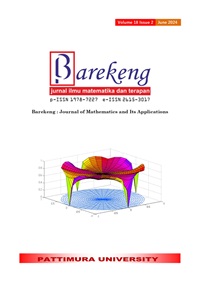APPLICATION OF COX PROPORTIONAL HAZARD REGRESSION FOR ANALYZING FACTORS INFLUENCING THE RECOVERY RATE OF PULMONARY TUBERCULOSIS PATIENTS
Abstract
Pulmonary tuberculosis is a serious disease that requires special attention from the community and the Government of Indonesia, especially the Maluku Province. One commonly used analytical method in the health field is survival analysis. Survival analysis is a statistical method related to observing the period until the occurrence of an event or events. This study aims to model and identify factors that affect the recovery rate of patients with pulmonary tuberculosis in Ambon City using Cox Proportional Hazard regression. The results of the Hazard Ratio interpretation show that the variables that have a significant influence are chest pain and night sweats. Specifically, patients experiencing chest pain exhibit a recovery rate 0.487264 times faster than those devoid of such symptoms. Similarly, patients experiencing night sweats demonstrate a recovery rate of 0.619839 times faster than their counterparts not experiencing this symptom. This study highlights the imperative of recognizing and addressing symptoms like chest pain and night sweats in managing pulmonary tuberculosis in Ambon City.
Downloads
References
D. G. Kleinbaum and M. Klein, Survival Analysis : A Self-Learning Text, 3rd ed., London: Springer Science+Business Media, 2012.
C. Kartsonaki, "Survival Analysis," Diagnostic Histopathology, pp. 263-270, 2016.
D. Collett, Modelling Survival Data in Medical Research, 3rd ed., Boca Raton: CRC Press, 2015.
Kemenkes RI, Profil Kesehatan Indonesia Tahun 2017, Jakarta: Kementrian Kesehatan RI, 2018.
PDPI, Perhimpunan Dokter Paru Indonesia, Tuberkulosis, Pedoman Diagnosis dan Penataklasanaan di Indonesia, Jakarta: Perhimpunan Dokter Paru Indonesia, 2021.
S. Smiljic, B. Radovic, A. Ilic, G. Trajkovic, S. Savic, Z. Milanovic and M. Mijovic, "Differences and similarities between the symptoms and clinical signs in patients with pulmonary tuberculosis and pneumonia," VOJNOSANITETSKI PREGLED , p. 192, 2016.
R. Loddenkemper, M. Lipman and A. Zumla, "Clinical Aspects of Adult Tuberculosis," Cold Spring Harbor Perspectives in Medicine, 2016.
F. Modeong, D. R. Isa, Djakaria, Ismail, Payu, M. R. F. and S. L. Mahmud, "Implementasi Model Cox Stratifikasi Interaksi dan Tanpa Interaksi untuk Mengidentifikasi Faktor-Faktor Laju Kesembuhan Pasien TB Paru," Research in the Mathematical and Natural Sciences , vol. 2, pp. 80-98, 2023.
A. Sengul, U. A. Akturk, Y. Aydemir, N. Kaya, N. D. Kocak and F. T. Tasolar, "Factors affecting successful treatment outcomes in pulmonary tuberculosis: a single-center experience in Turkey, 2005–2011," The Journal of Infection in Developing Countries, pp. 821-828, 2015.
R. Kemenkes, "Rilis Kementrian Kesehatan," 2023. [Online]. Available: https://www.kemkes.go.id/id/rilis-kesehatan/deteksi-tbc-capai-rekor-tertinggi-di-tahun-2022. [Accessed 11 2023].
R. Kemenkes, Laporan Program Penanggulangan Tuberkulosis Tahun 2022, Kemenkes RI, 2023.
A. R. Faisal, M. N. Bustan and S. Annas, "Analisis Survival dengan Pemodelan Regresi Cox Proportional Hazard Menggunakan Pendekatan Bayesian (Studi Kasus: Pasien Rawat Inap Pnederita Demam Tifoid di RSUD Haji Makassar)," VARIANSI: Journal of Statistics and Its Applcation on Teaching and Research, 2020.
L. Li, Z. Yang and Z. Chen, "Moving beyond the Cox proportional hazards model in survival data analysis: a cervical cancer study," BMJ Publishing Group, 2020.
D. London, Survival Models and Their Estimation, Winsted: ACTEX Publications, 1997.
E. T. Lee and J. W. Wang, Statistical Methods for Survival Data Analysis, 3rd ed., New Jersey: John Wiley & Sons, Inc. , 2003.
S. Guo, Survival Analysis, New York: Oxford University Press, 2009.
Collet and David, Modelling Survival Data in Medical Research, Boca Raton: Taylor & Francis Group, 2015.
D. Collet, Modelling Survival Data in Medical Research, US: Chapman & Hall, 2003.
S. L. Spruance, J. E. Reid, M. Grace and M. Samore, "Hazard Ratio in Clinical Trials," Antimicrobial Agents and Chemotherapy, pp. 2787-2792, 2004.
B. M. Iskandar, "Model Cox Proportional Hazard Pada Kejadian Bersama," SKRIPSI, 2015.
N. A. Tuanaya, "Analisis Faktor Yang Memengaruhi Laju Kesembuhan Pasien Tuberkolosis Paru di Kota Ambon Tahun 2021 Menggunakan Regresi Weibull," Program Studi Statistika, Universitas Pattimura, Ambon, 2023.
Copyright (c) 2024 Asrul Irfanullah, Ferina Lestari Damamain, Nur Amaliya Tuanaya

This work is licensed under a Creative Commons Attribution-ShareAlike 4.0 International License.
Authors who publish with this Journal agree to the following terms:
- Author retain copyright and grant the journal right of first publication with the work simultaneously licensed under a creative commons attribution license that allow others to share the work within an acknowledgement of the work’s authorship and initial publication of this journal.
- Authors are able to enter into separate, additional contractual arrangement for the non-exclusive distribution of the journal’s published version of the work (e.g. acknowledgement of its initial publication in this journal).
- Authors are permitted and encouraged to post their work online (e.g. in institutional repositories or on their websites) prior to and during the submission process, as it can lead to productive exchanges, as well as earlier and greater citation of published works.






1.gif)



